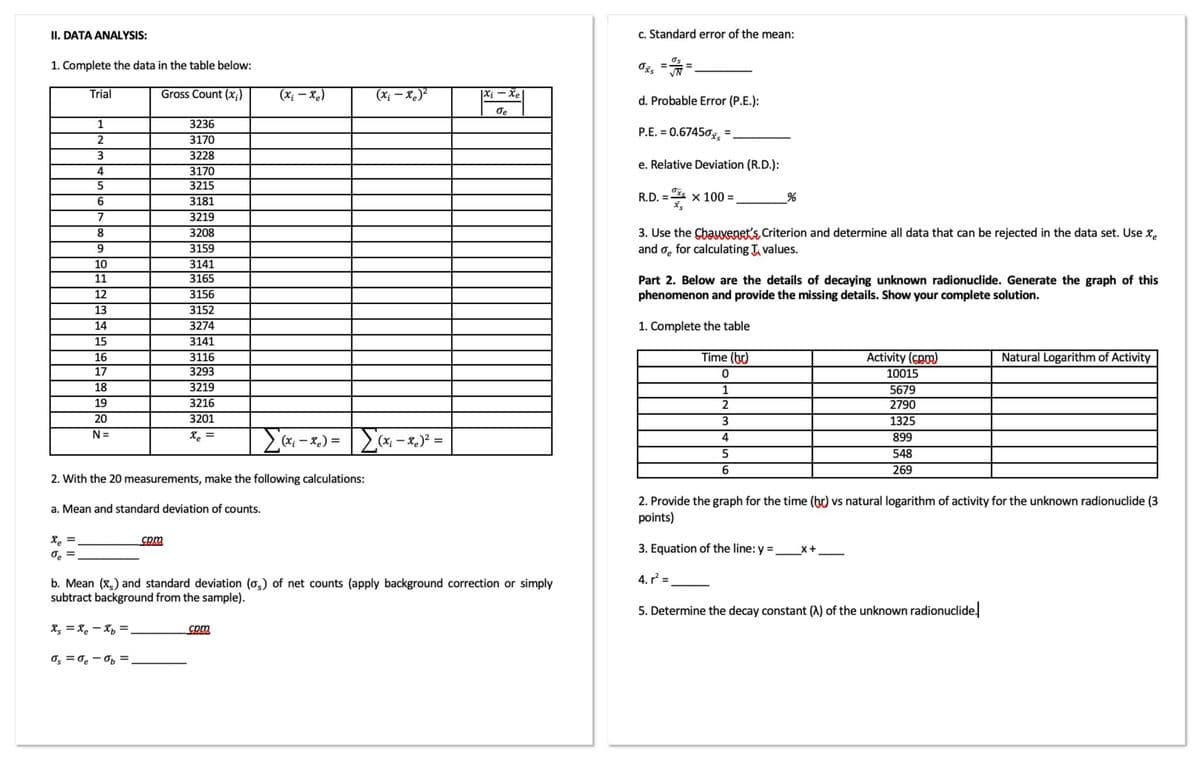II. DATA ANALYSIS: c. Standard error of the mean: 1. Complete the data in the table below: O, == Trial Gross Count (x) (x - x.) (x - x.) |Xi-Xe d. Probable Error (P.E.): de 3236 P.E. = 0.67450g, = 2 3170 3 3228 e. Relative Deviation (R.D.): 4 3170 3215 6 R.D. = x 100 =, 3181 3219 7 3208 3. Use the Chauvenets Criterion and determine all data that can be rejected in the data set. Use x, and o, for calculating T values. 8 3159 10 3141 11 3165 Part 2. Below are the details of decaying unknown radionuclide. Generate the graph of this phenomenon and provide the missing details. Show your complete solution. 12 3156 13 3152 14 15 3274 1. Complete the table 3141 3116 Time (h) Natural Logarithm of Activity 16 17 Activity (cpm) 10015 5679 3293 3219 3216 3201 18 1 19 20 2 2790 1325 N= X, = (x - x.) =(x -x) = 4. 899 548 6 269 2. With the 20 measurements, make the following calculations: 2. Provide the graph for the time (br) vs natural logarithm of activity for the unknown radionuclide (3 points) a. Mean and standard deviation of counts. com 3. Equation of the line: y = x+ o. = 4. r= b. Mean (x,) and standard deviation (o,) of net counts (apply background correction or simply subtract background from the sample). 5. Determine the decay constant (A) of the unknown radionuclide x, =x, -x, = Com o, = 0, - O =.
II. DATA ANALYSIS: c. Standard error of the mean: 1. Complete the data in the table below: O, == Trial Gross Count (x) (x - x.) (x - x.) |Xi-Xe d. Probable Error (P.E.): de 3236 P.E. = 0.67450g, = 2 3170 3 3228 e. Relative Deviation (R.D.): 4 3170 3215 6 R.D. = x 100 =, 3181 3219 7 3208 3. Use the Chauvenets Criterion and determine all data that can be rejected in the data set. Use x, and o, for calculating T values. 8 3159 10 3141 11 3165 Part 2. Below are the details of decaying unknown radionuclide. Generate the graph of this phenomenon and provide the missing details. Show your complete solution. 12 3156 13 3152 14 15 3274 1. Complete the table 3141 3116 Time (h) Natural Logarithm of Activity 16 17 Activity (cpm) 10015 5679 3293 3219 3216 3201 18 1 19 20 2 2790 1325 N= X, = (x - x.) =(x -x) = 4. 899 548 6 269 2. With the 20 measurements, make the following calculations: 2. Provide the graph for the time (br) vs natural logarithm of activity for the unknown radionuclide (3 points) a. Mean and standard deviation of counts. com 3. Equation of the line: y = x+ o. = 4. r= b. Mean (x,) and standard deviation (o,) of net counts (apply background correction or simply subtract background from the sample). 5. Determine the decay constant (A) of the unknown radionuclide x, =x, -x, = Com o, = 0, - O =.
Glencoe Algebra 1, Student Edition, 9780079039897, 0079039898, 2018
18th Edition
ISBN:9780079039897
Author:Carter
Publisher:Carter
Chapter10: Statistics
Section10.5: Comparing Sets Of Data
Problem 13PPS
Related questions
Question

Transcribed Image Text:II. DATA ANALYSIS:
c. Standard error of the mean:
1. Complete the data in the table below:
Trial
Gross Count (x;)
(Xị – Xe)
(x; - Xe)
d. Probable Error (P.E.):
Oe
3236
P.E. = 0.67450g,
3170
3228
e. Relative Deviation (R.D.):
4
3170
3215
3181
R.D. =s x 100 =
%3D
7
3219
3. Use the Chauxenet's Criterion and determine all data that can be rejected in the data set. Use x.
and o, for calculating J, values.
8
3208
3159
10
3141
11
3165
Part 2. Below are the details of decaying unknown radionuclide. Generate the graph of this
phenomenon and provide the missing details. Show your complete solution.
12
3156
13
3152
14
3274
1. Complete the table
15
3141
16
3116
Time (br)
Activity (cpm)
Natural Logarithm of Activity
17
3293
10015
18
3219
1
5679
19
3216
2790
20
3201
1325
N =
Xe =
(x; – x.) = | (x; - x,)? =
899
548
6.
269
2. With the 20 measurements, make the following calculations:
2. Provide the graph for the time (br) vs natural logarithm of activity for the unknown radionuclide (3
points)
a. Mean and standard deviation of counts.
Xe =
Oe =
com
3. Equation of the line: y =,
4. r' =
b. Mean (x) and standard deviation (o,) of net counts (apply background correction or simply
subtract background from the sample).
5. Determine the decay constant (A) of the unknown radionuclide.
X, = Xe - X, =
cpm
Os = 0e - Op =
Expert Solution
This question has been solved!
Explore an expertly crafted, step-by-step solution for a thorough understanding of key concepts.
Step by step
Solved in 3 steps

Recommended textbooks for you

Glencoe Algebra 1, Student Edition, 9780079039897…
Algebra
ISBN:
9780079039897
Author:
Carter
Publisher:
McGraw Hill

Glencoe Algebra 1, Student Edition, 9780079039897…
Algebra
ISBN:
9780079039897
Author:
Carter
Publisher:
McGraw Hill